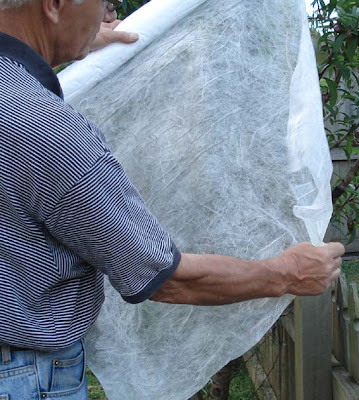We struggle against the fruit fly here in late spring and summer. I am pleased they don't go for our tomatoes, we had them once in the capsicums (peppers), but usually they zero in on the peaches and nectarines. Last year we used exclusion bags with limited success and exclusion sleeves that were better, this year we're trying tree cloth.
Tree cloth is a product Hanno found in the local hardware store. It's a roll of strong paper cloth that allows in 80 percent natural light. It's a closed weave cloth, suitable for excluding tiny insects. The only problem with the tree cloth is that you either have to make bags with it - and I have no solar proof thread - or you have to wrap the tree like an ugly parcel. This is what we did. I take heart in knowing it's on there only for another couple of months until we harvest the fruit.
We wrapped the nectarine tree on the weekend - it's my favourite fruit. The nectarines from this tree are sweet and delicious and much tastier than any store-bought fruit I've ever eaten. Hanno and I disagree on how we should wrap - I wanted to wrap individual branches, he wanted to wrap the whole tree. It must be a boy thing. ;- ) So that is what we did but when we wrap the peach tree in a few days time, it will be wrapped as individual branches. I think that will be better as we will get a tighter fit and we just have to cover the branches with fruit on them.
If you are thinking of doing something like this, you do it after the blossoms have been pollinated and the fruit have formed - the cloth will also keep out bees. When the fruit are small, but before your known insect season, you wrap your tree, or cover with exclusion bags.

We found this one perfect, ready-to-eat peach on the weekend and, of course, ate it straight away. It has ripened well out of season but even though it was not as sweet as they will be later on, it still tasted good.
To tell you the truth, it is a real pain to do it this but it's like protecting precious jewels that will be eaten if you do it well. We keep our fruit trees pruned to the height we can reach so wrapping the tree wasn't as difficult as it might have been if we had let the trees grow to their natural height.
Now all we need to do is water the tree and wait ... but that's the really difficult part.



